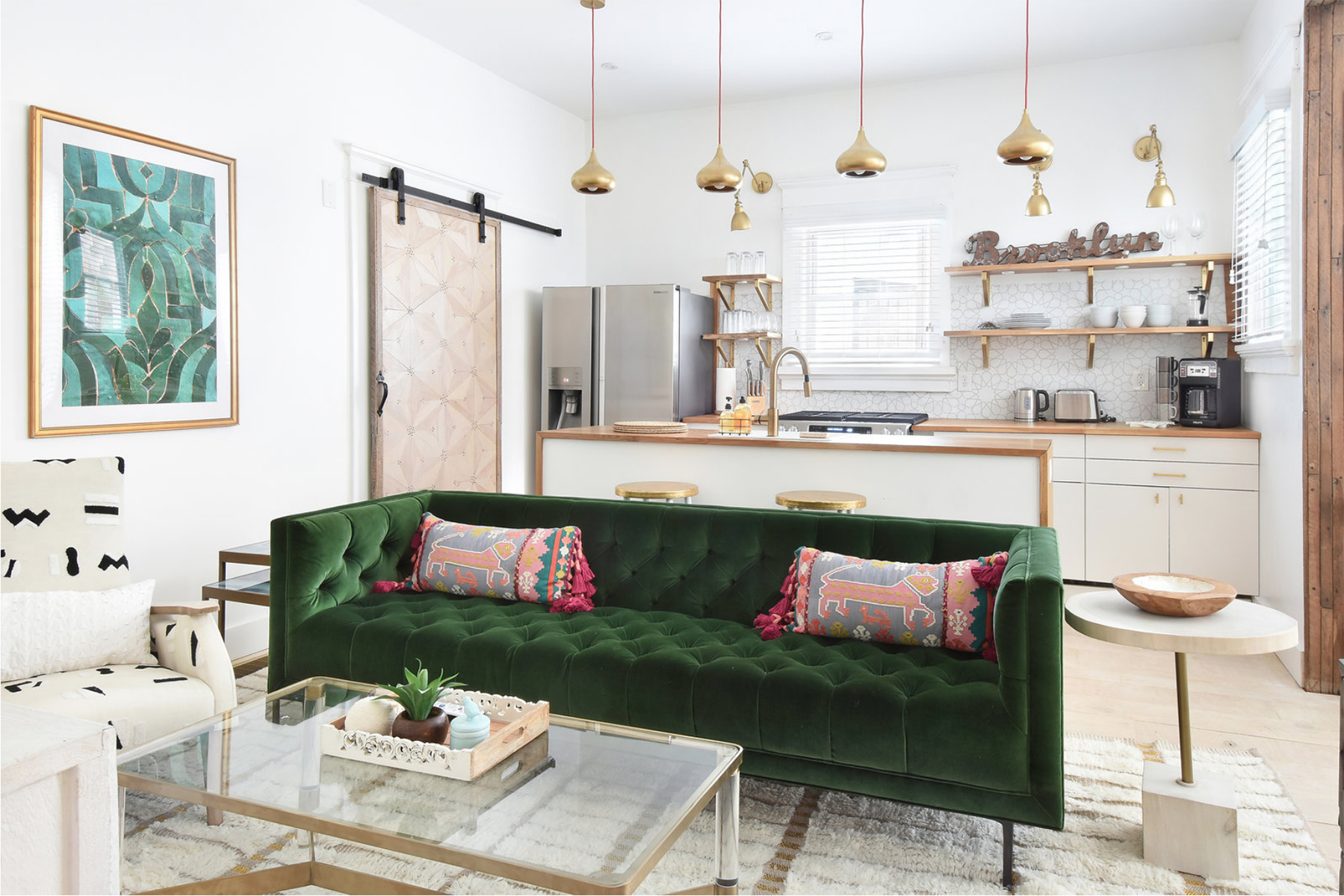We may earn revenue from the products available on this page and participate in affiliate programs.
It’s generally best to steer clear of cliches, but when said cliches turn out to be sage real estate advice, the rule does not apply.
In this case, the adage “buy the ugliest building on an expensive block” proved extremely beneficial for designer Sidra Gross. Looking to buy an apartment in Atlanta to rent out on Airbnb, she stumbled upon this 1,000-square-foot space now dubbed “The Jade Apartment.” Enticed by the home’s strong bones and ideal location mere blocks from both a local park and Trader Joe’s (an important Atlanta landmark), Gross and her team took on the fixer-upper.


Now, thanks to a gut renovation that added a bedroom and a more efficient layout, the new space is totally unrecognizable. “I would describe my style as whimsical modern,” says Gross of the apartment’s style. “I like clean, open spaces and straight lines, but at the same time, I love ornamentation. Layering and pushing and pulling different styles is what makes spaces exciting to be in.”

This juxtaposition is clear in the home—sleek brass light fixtures coexist in the same room as globally inspired textiles. It’s all set against pale plywood (the budget-friendly material Gross says kick-started the renovation) and bright white walls that instantly lightened up the home. Custom touches like floor-to-ceiling closets and intricately detailed barn doors make the space feel more elevated than your average modern apartment.

But the most impressive thing about this renovation may just be its price tag. The entire project came in at under $25,000, and aside from one minor regret—“I wish I had coughed up the money for hardwood flooring,” says Gross—it ended up being perfect.

We spoke to the designer to learn about how she managed such a massive transformation on a tight budget. If you’re planning your own gut renovation, the below tips should definitely inspire confidence. After all, if $25,000 can allow for an extra bedroom and custom woodwork, there’s hope for us all.
Start with realistic expectations
The one thing Gross says people should know before undertaking a gut reno? “There are going to be surprises. Your budget shouldn’t be strung out when you start,” she cautions. In order to avoid stress down the line, Gross recommends planning for a budget buffer of 10 percent to 25 percent (depending on how experienced you are) to allow for unforeseen costs.
Know where to splurge and save
“It’s the details that make a space special,” says Gross. Small accents that elevate a space in an understated manner are worth the investment. Meanwhile, look to DIYs for ways to save. In this space, she used a $25 stencil for the kitchen backsplash instead of splashing out on bespoke tiles. Don’t discount big-box retailers, either. “IKEA is not your enemy,” she says. “I used IKEA cabinets and countertops in my kitchen, and they look fabulous with the more expensive elements.”
Repurpose as much as possible
Upcycling is in style. Not only is it a sustainable way to design, but it oftentimes brings character to a space that just can’t be replicated with new, “vintage-inspired” pieces. “When we were demoing, we found a lot of very cool 100-year-old wood inside the walls. It’s part of the story of the home, and we wanted to reference its history even within our new remodel,” explains Gross. She used this wood as much as possible—most notably in the trim of the custom barn doors.
Play tricks on the eye
This apartment is chock-full of smart projects even the most novice of decorators can mimic. Aside from the stencil backdrop, there are other visual tricks Gross used to transform the space. First of all, instead of splurging on an extravagant bed, spend money on a cool headboard instead and mount it directly to the wall—this saves money, and people will never be able to tell the difference. Also, feign larger windows by mounting curtains as close to the ceiling as possible.
Play favorites
“For your bathrooms, choose an accent wall for your more expensive tile and find the cheapest tile you can for all other areas,” says Gross. “I love to use penny tile and subway tile next to something more precious to save money.”
Shop smart
Before starting your renovation, bookmark some retailers to routinely check for deals. A few of Gross’s favorites include Etsy, which she uses for hardware and lighting, Cypress Tile, which she loves for its large-format subway tiles and sporadic free shipping, and HomeGoods, which she says is her go-to spot for finding bargain accent pieces.
Gross also recommends Amazon Warehouse, a section of the retailer’s site where you can peruse items that have been returned or lightly used and where you can find hidden gems. But her biggest score was discovering a New Jersey store called Final Cut; it offers Anthropologie goods at up to 90 percent off.
Don’t make this common budgeting mistake
“The biggest mistake when trying to stick to a budget is not spending the money when it’s a matter of function,” explains Gross. “It can be doubly as expensive to, later on, replace a cheap-in-the-moment choice.” Another budgeting mistake? Not setting enough money aside for labor and construction materials. According to the designer, this is always going to be the biggest cost of any renovation. Plan accordingly.
See more renovation tips: Experts Share Their Tips for Budget-Friendly Renovations This Is the First Step When Planning a Renovation How to Get Your Dream Kitchen at a Dream Cost



